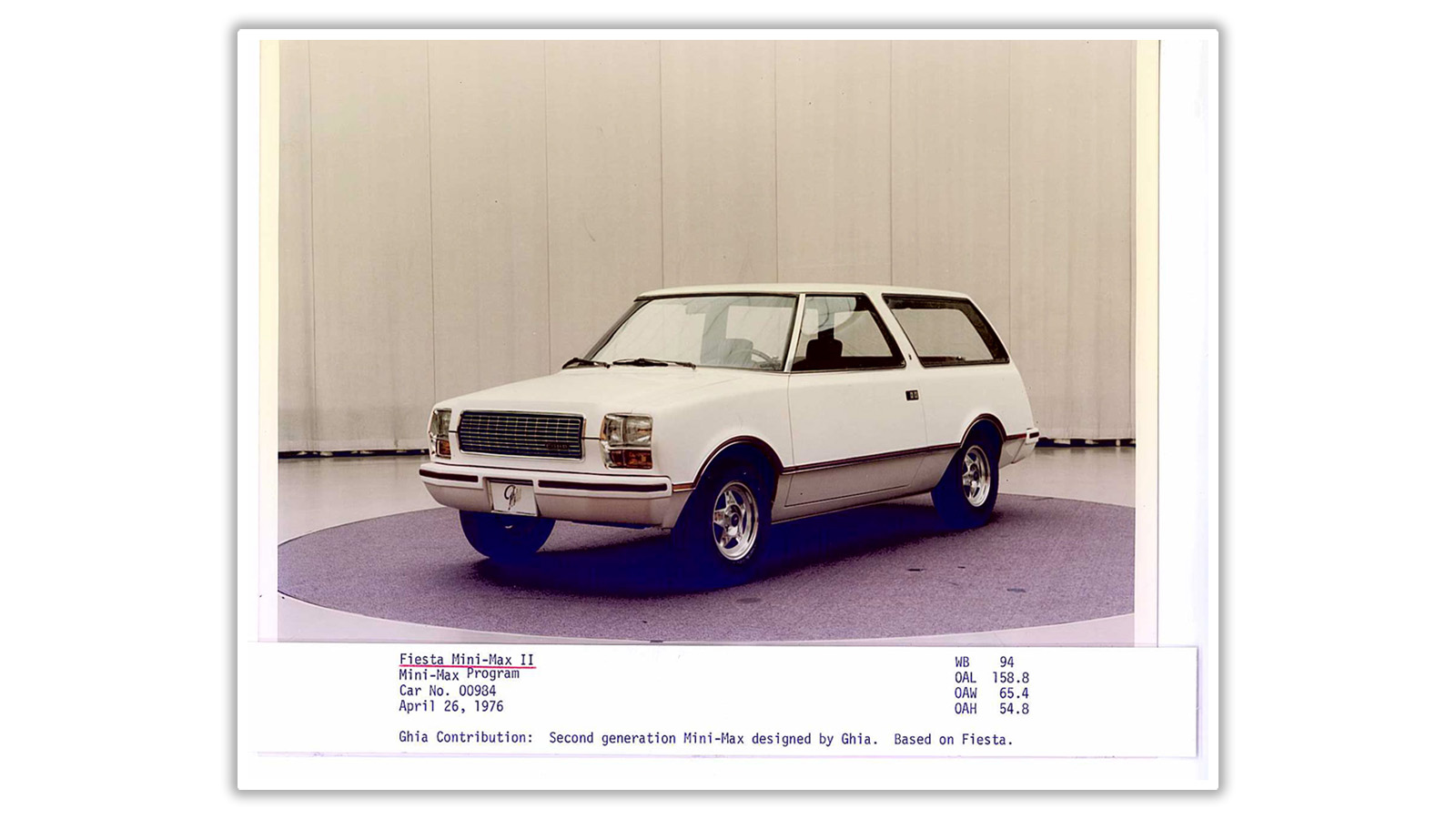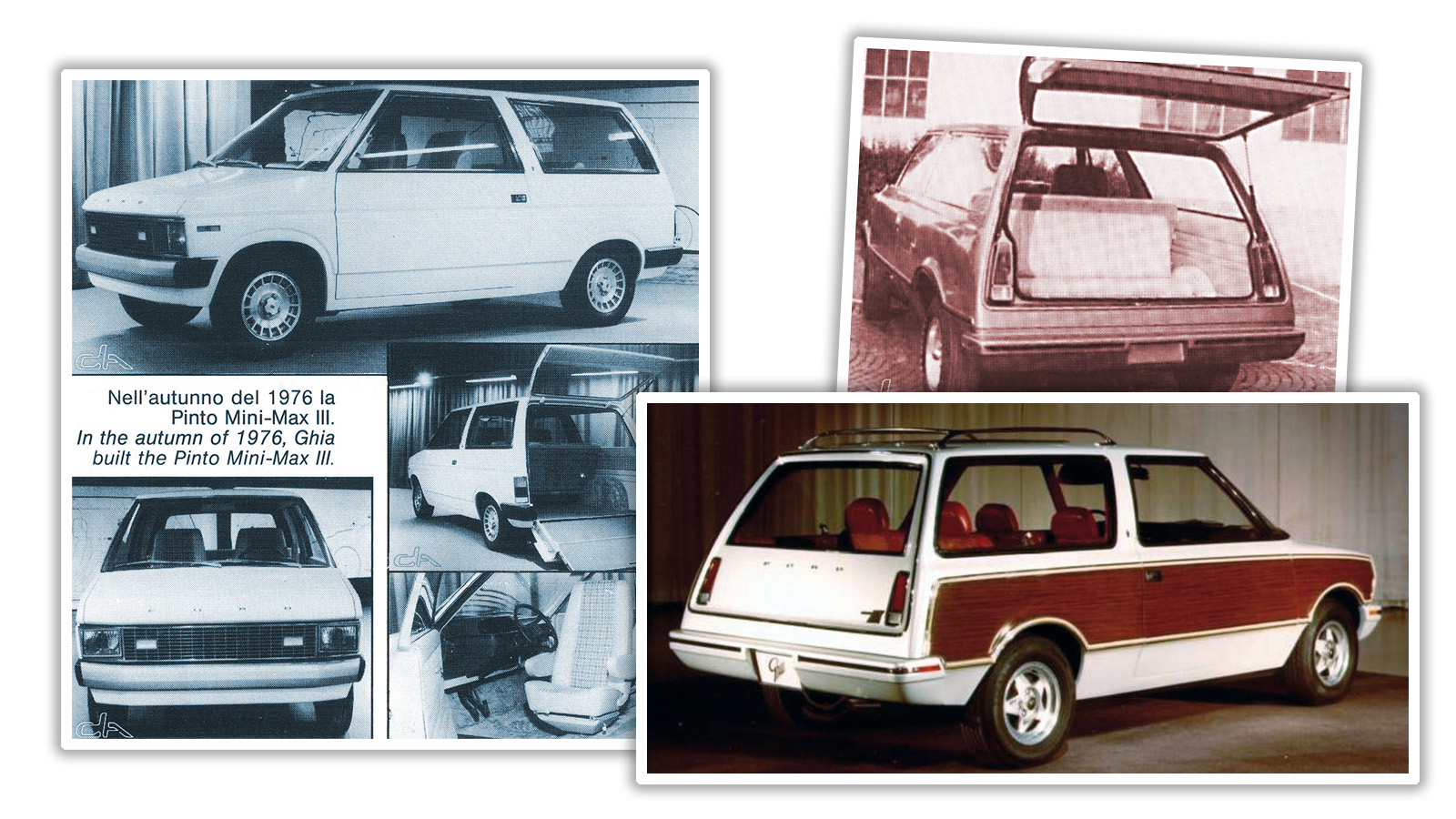I’d heard about this before, usually in the context of a 1972 project at Ford known as the Carousel. This was a “garagable van” that was built on a chassis derived from Ford’s full-size Econoline vans, and used the Econoline’s V8/rear-wheel drive setup.
As I’ve usually heard this story told, the Carousel project was led by Lee Iacocca, and was shut down by Ford executives in 1974, partially out of fears that it would cannibalize sales of Ford’s popular Country Squire and other station wagons. When Iacocca was fired from Ford in 1978, he took the general concept with him to Chrysler, where it was developed into the front wheel-drive Chrysler minivans. So, that’s what I always heard: it started as a RWD smaller van, and it wasn’t until the idea made it to Chrysler that the leap to FWD (and all of its related packaging advantages for a van) came about. But what I’ve now learned is that there was another minivan project at Ford, and this one was far closer to what the Chrysler minivans would be, because this was a smaller, FWD van. It was called the Mini-Max.
A post shared by Car Design Archives (@cardesignarchives) I learned about this remarkable missing link from the excellent Car Design Archives group, as well as from Dean’s Garage. The Mini-Max project seems to have been in operation roughly in parallel with the Carousel, differentiated because the Mini-Max was a much more compact design, and it originated at Ghia studios in Italy, which Ford had bought in 1970. The designer in charge of the Mini-Max project, Don DeLaRossa, who was also instrumental in the design of the Falcon years before, really believed in the idea of a compact minivan, and pushed the project at Ford enough that four working prototypes were built. Three of the prototypes were based on Ford of Germany’s FWD Fiesta platform: the 1973, Mini-Max I, the 1975 Bobcat Cheetah Fox Van, and then the 1974 Mini-Max II. A 1976 Mini-Max III was built on a Pinto platform, perhaps re-worked to be FWD? It’s not exactly clear. The body design was a bit divergent from what we understand minivans in terms of doors, as these were essentially two-door wagons, with no sliding rear doors. Let’s take a look at these four Mini-Max vehicles, because they’re fascinating:
Here’s the first, the 1973 one, and you can see lots of 1970s Ford styling cues in there, especially the front end, which has a lot of Mustang II in it, especially with those body-colored plastic bumpers with the silvery trim strips inset into them. More importantly, though, is that eagle graphic along the side! Holy crap, that’s cool. Why didn’t that trend catch on for minivans? Nobody would be calling them soccer mom cars if they had huge birds of prey screaming down their sides!
This 1975 version was seen as being part of the Bobcat program, and in case one wild cat name isn’t enough, this one was called the Bobcat Cheetah for double the cat-ness, and then just for good measure, Ford tacked another animal on there, a Fox, so this thing was called the Bobcat Cheetah Fox Van 2-door. That’s a whole zoo. The styling is clearly pushing into Ford’s 1980s design language, with the rectangular headlamps and the overall more crisp, rectilinear style. It’s very tidy and clean, with a lot of window area.
Another Fiesta-based Mini-Max II was built in 1976, with essentially the same basic styling as the 1975 Bobcat Cheetah Fox one, but with some tweaks, like a simplified front bumper.
This third version, also from 1976, is the Pinto-associated one, though looking at it, I can’t help but think the Pinto designation was for branding purposes only, as that short hood really suggests a transverse engine layout like on the Fiesta. The overall styling here is very much predicting 1980s auto design: rectangular headlamps, full-width grille, minimal chrome trim, crisp character lines, sharp corners, and bumpers with black rubber end caps. The benefits of the FWD layout can be appreciated really well here, as there’s pictures of the cargo area of the Mini-Max III:
Look at all that space, and that gloriously flat floor! Plus, we have an interesting hatch-and-tailgate layout, and that tailgate even seems to have an extendible ramp! This is a very practical design.
You can get a sense of the scale of it here, with ’70s Abraham Lincoln and his friends there standing behind the car. It was quite tall, definitely not a small wagon, but still much more compact than vans of the era. A genuine minivan, even if it only had two doors.
I think the white 1976 Mini-Max II had wood paneling on one side, and it does look pretty good on there. Also notable is that the MiniMax II seemed to have a third row, rear-facing jump seat, and the taillights were visible through the tailgate via holes! It’s sort of like how the early Mini Clubman wagons had their taillights visible via holes in the door hinge areas. The Mini-Max met the same fate as the Carousel project, in this case killed by none other than Henry Ford II, who liked neither compact cars or FWD. When Iacocca went to Chrysler in 1978, he took designer DeLaRossa with him, and DeLaRossa in turn took with him the ideas and it seems drawings of the Mini-Max, which he regarded as a huge missed opportunity for Ford. In fact, according to Car Design Archives, at least one of the prototypes made it to Chrysler, as DeLaRossa made a point “to avoid their destruction, he discreetly has all these concepts transferred to a Detroit drug warehouse.” A drug warehouse? This could be a translation issue, but it’s certainly a hell of a story. The result of all of this is that when Iacocca and his team ended up at Chrysler, they came armed with about a decade’s worth of research and development about minivans, and not just the bigger, RWD-style vans like the Carousel, as I had always thought, but FWD minivans from the Mini-Max project, which very directly were applicable to the sort of K-Car FWD-based van Chrysler would start selling in 1983. I don’t think I’ve ever quite realized just what an amazing deal Chrysler got with Iacocca and his team. No wonder the Chrysler Minivans were such a success; they were standing on the shoulders of mini-giants. Since Autopian takes eternity in approving the comments with links (except that one with fast money scheme), I am posting the link in the reply. Or you can enter “Chevrolet Nomad II concept” in search engine. https://gmphotostore.com/1979-chevrolet-nomad-concept-poster/ Maybe, MAYBE there’s a connection here between the drug warehouse and DeLorean going down! DeLaRossa, DeLorean. OPEN YOUR EYES, PEOPLE. Sliding doors, flat floor, and 3 row seating. That’s the success formula of the minivan. That plaid seating is interesting, though…. One of the big hurdles they were facing was emissions and CAFE requirements. It just didn’t make sense to attempt to make their SV capable of meeting the 1981 emissions requirements. So they looked at purchasing complete engines from other sources. One option was to go all diesel and they did a couple of different prototypes there. Of course they were rightly scared of an all diesel line up so they started shopping and trying gas engines as well. They started and stopped with the company that had been supplying their ATs and who they originally purchased the Scout diesel engine from Chrysler. So 225 slant 6 and 318 V8 prototypes were also built. When the big report and proposal didn’t impress the board they made one last ditch effort to keep their jobs. Sell the Scout Business Unit to anyone. Again one of the companies they approached was Chrysler. Chrysler’s people were interested and did their due diligence, so they undoubtedly were shown the proposal the unit had made for future products as well as the clay of the Scout III. Well when the deal fell through many of the engineers and designers found new jobs at Chrysler. I know the sketches of the mini-van are out there on the web as are those of the SIII wearing the grille that eventually showed up on the Town and Country version. Here is the article where the pictures of the III used to reside. https://jalopnik.com/have-a-look-at-the-1980s-international-scout-that-never-1758491270 where they mention the T&C grille. 1970s Chrysler Europe was a convoluted hodge-podge of national subsidiaries. Essentially, all during the 1960s Chrysler had been buying up all sorts of Western European car industry oddballs and cast-offs, with little effort to build them into a cohesive group. There was the infamous Rootes Group in England, with its alphabet soup of brands (Hillman, Sunbeam, Humber, and so on). Then there was France’s Simca, initially Fiat’s French subsidiary, before buying up Ford France in the 1950s and going its own flamboyant way. Also in France, Chrysler had taken a stake in Matra Automobiles, a car-making subsidiary of aerospace and weapons group Matra that had specialised in making small plastic-bodied, mid-engined sportscars. Finally, in Spain, it had taken a stake in Barreiros, the creation of a Diesel-obsessed self-made man that had become a major truck maker before building Dodge Darts under license. In the early-to-mid 1970s, the minivan idea seems to have brewed in the creative minds of Chrysler-Rootes in England, finally leading to a series of mockups under the “Supervan” concept. At the same time, Simca and Matra had started selling the Matra-Simca Rancho, a pseudo-offroader based on the Simca 1100 subcompact which can genuinely be considered the first crossover. In a rare case of cross-pollination between Chrysler’s European subsidiaries, Matra appears to have heard of Rootes “Supervan” ideas, and developed its own P16 concept, as a bigger successor to the Rancho. Unfortunately for Matra and Chrysler, two things then happened. First of all, in 1978, ailing Chrysler sells off its European subsidiaries to Peugeot. Then, in 1979, the oil crisis strikes, dealing an almost-deadly blow to Peugeot, which was having trouble digesting Chrysler Europe on top of its previous acquisition of Citroën. So, when the Matra people call Peugeot to propose their minivan idea, successively reworked to fit Peugeot and Citroën bases, Peugeot rebuffs them, and lets them free to discuss it with other carmakers, including arch-rival Renault. In 1982, Matra presents them their P23 prototype, now based on a Renault 18 chassis. The Renault honchos are enthused by the idea, and two years later, in the heels of the Chrysler minivans in the US, Renault introduces its own Renault Espace, produced by Matra, in the European market. There was even the idea to sell it in the US through its then-subsidiary AMC, but that sank together with Renaults whole American venture by the end of the decade…








